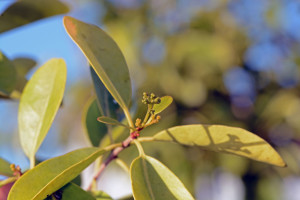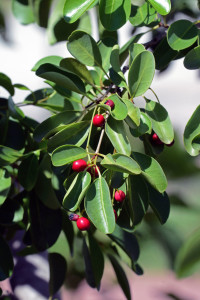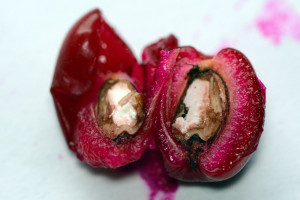Four and a half years ago we moved into a new house. This involved a lot of new things: first, and most importantly, of course, a new baby boy. Happy, shiny day. Also, relatively easy to determine the sex (baby humans have dangly bits).
Baby plants, though, don’t have such obvious markers of sex. For example, right around the time we were moving into our lovely new home with our lovely new baby boy, I was planting a lovely new garden. And I put in a lovely little tree called a Blolly (Guapira discolor).
As with most plants, though, unless you’re lucky enough to catch it in fruit or in flower, it’s hard to tell whether it’s a male, female, or both. (Plants that are both male and female are called dioecious; plants that are one or the other are monoecious. Flowers that are both male and female—that is, they bear both male stamens and female pistils—are called “perfect.”)
And when plants are young, they’re not likely to bear either fruit or flower, particularly the slow-growing trees like the blolly.
Like humans, the blolly tree is dioecious, which means it has separate male and female plants. (Unlike humans, though, it’s usually the female plant that carries the dangly bits.)
Unfortunately, I’ve never been able to find a good picture of either male or female flowers of this plant, so I’ve never known whether my little tree was a boy or a girl. And it’s important to know, because when you have dioecious plants, if you want to ensure that they bear fruit, you need to have both male and female in relatively close proximity so pollination can occur. (Anyone who’s read this blog knows that I have a whole host of busy pollinators to make that happen.)
Trouble is, blolly flowers are so darn small that even when I see them, I can’t see whether they have stamens or pistils. (And I’m such a hands-off naturalist that I don’t even try to dissect them myself; perhaps something to consider?) So it would be really helpful to have a picture or a description of male and female flowers, so I could know which blolly to plant next: male, or female?
The paucity of flower pictures has a reason. My two native plant guides that discuss this tree (Huegel 2010 and Osorio 2001) give a clue as to why pictures of the flowers are hard to find. They each say something to the effect that “the small greenish flowers are inconspicuous” (Osorio) but that the flowers are followed several months later by “clusters of 1/3-inch bright red fruit. . . that rarely last long as they are eaten quickly by birds” (Huegel).
Here are the only flowers I’ve seen on this plant, captured back in April of this year; I’d have to agree that they are indeed “inconspicuous”:

From that photo, can anyone tell me whether they’re male or female?
Knowing what I know now, I can: they’re female. How do I know? Well, here’s what they turned into:

Showy red fruits indeed! And those dangly red bits would seem to indicate that I have a female blolly.
Here’s a picture of a seed:

However, here’s the hard part—I still don’t know whether my blolly is male or female! Why not?
Because the blolly, I’m told by my nursery lady, can actually change from being dioecious to monoecious when its counterpart isn’t available. Intriguing, no?
Given that bit of information, I just had to find out more.
I have to warn you: If you’re looking around on the web and trying to find out more about how plants change sex, good luck. There’s a lot of noise and not much signal. All of my search engine results are cluttered with people asking how to change their marijuana plants from male to female. I did find this summary of an article in Oecologia from 1980 that seemed like it might at least present evidence that such changes are not uncommon, although it doesn’t sound like it goes into specifics on how the change occurs.
So I emailed Rufino Osorio, the man who seems to know everything about Florida native plants, and here is what he told me:
If a label must be placed on your plant, here are two such labels that you can use:
If your plant is female, and it produced a few male flowers that pollinated a few female flowers leading to fruit production, then your plant is subgynoecious (having female flowers with a few male or perfect flowers).
If your plant is male, and it produced a few female flowers that got pollinated by the male flowers, then your plant is subandroecious (having male flowers with a few female or perfect flowers).
Note that these labels do not apply to blolly as a species. They apply only to your plant. As a species, blolly is dioecious. And blolly, as a species, does not stop being dioecious simply because a few individuals might occasionally deviate from strict dioecy. It’s just like people—human beings, as a species, are not described as albino simply because an occasional human being is born with the complete absence of melanin.
In order to test the “basic” sexuality of my plant, I’ll have to wait until I see more flowers, find out whether they’re mostly male, mostly female, or all male or all female, and proceed from there.
Yay, homework!
References
Huegel, C. 2010. Native Plant Landscaping for Florida Wildlife. Gainesville: U of Florida P.
Osorio, R. 2001. A Gardener’s Guide to Florida Native Plants. Gainesville: U of Florida P.
